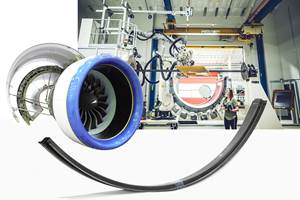Improving laminates through anisotropy and homogenization
Dr. Stephen Tsai, professor research emeritus in the Department of Aeronautics & Astronautics at Stanford University, discusses the merits of unbalanced (anisotropic) layers in composite laminates.
In composites design, the symmetric or balanced laminate, consisting of four fixed angles of unidirectional layers, has been the choice of designers for years because of its metal-like behavior. Unbalanced layers, for example [0°/25°], are never used but it is now known that they can offer unexpected benefits that are not possible with balanced laminates. Such a two-angle [0°/25°] building block, developed at Stanford University (pat. pend.), has been designed to increase not only strength, by suppressing matrix cracking, but also to offset deformation from shear coupling associated with anisotropic layers.
Bi-angle laminates can have ply stresses engineered to work synergistically. A [0°/25°] beam has 39 percent less deflection and more than 30 percent higher first natural frequency than four-angle quasi-isotropic laminates. Additionally, the beam has 15 percent less thickness and is only 55 percent of the weight of aluminum for the same deflection.
Structures can be built with single-axis layup with this pre-plied two-angle layer, rather than a four-axis layup for four-angle laminates. This unique single-axis option results in higher layup speed, less error in alignment, less wrinkling, and more value. Further, bi-angle layers can be mirrored [0°/±25°/0°] to form a layer capable of withstanding a fully reversible twist.
If bi-angle layers are laid up by hand, cutting the shallow 25° ply can be time consuming and result in excessive scrap. This can be avoided by using premanufactured noncrimp fabric (NCF). Stitching machines can mass produce [0°/25°] and [0°/-25°] in single layers. Additionally, the off-axis ply can be varied to match the loads. This continuous angle optimization is easier than creating discrete ply jumps in fixed angles in a laminate.
An NCF can have plies that incorporate unidirectional tapes made by a tow-spreading process, resulting in mass as low as 75 g/m2 per ply or 150 g/m2 per two-angle layer. A 2-mm/0.08-inch thick laminate, then, can have 32 plies. This bi-angle NCF has strength comparable to that of unidirectional prepreg. In addition, thin plies form stronger and tougher laminates because the layers are more finely dispersed. Minimum-gage laminates also are more easily designed with two-angle layers. This innovative thin-ply NCF has been pioneered by Chomarat (Le Cheylard, France).
The difference between symmetrical and asymmetrical laminates disappears when more than 16 bi-angle layers are stacked. Continuous stacking makes the location of, and reversing the order of stacking relative to the midplane, irrelevant. Concern about warpage during cure vanishes because the large number of repeated layers homogenizes the laminate. Also the tendency toward delamination is reduced for highly homogenized laminates.
Stiffened structures can be made with the same two-angle layer, minimizing the interlaminar stresses between, for example, a wingskin and its stringers. Ply drops can be made layer by layer and located at either the outer surfaces or in the interior. In fact, the optimum ply thickness is relative. Homogenization is approximated with 32 plies; if the required laminate thickness is 4 mm/0.16 inch, the optimum ply areal weight would be 150 g/m2. Instead of the traditional ply-by-ply model in analysis, a homogeneous anisotropic material now can be used. The
increase in speed is about n, or 32 times faster than the traditional ply-by-ply modeling.
Three different bi-angle NCF designs have been consolidated using a proprietary infusion process (pat. pend.) developed by ADVAERO Technologies Inc., Joint School of Nanoscience and Nanoengineering, VX Aerospace (Morganton, N.C.) and North Carolina A&T State University (Greensboro, N.C.); by resin film infusion and by pultrusion at KaZak Composites (Woburn, Mass.); and by prepreg, using a unique in-house epoxy by Aldila Materials (Poway, Calif.). Laminate testing under static and impact loading is under way at NASA Marshall Space Flight Center (Huntsville, Ala.), and fatigue testing is ongoing at Exova (Mississauga, Ontario, Canada). This new [0°/25°] building block for laminated structures is ready for application with unmatched quality and value. Simultaneous weight and cost reduction can finally be realized.
Those interested in receiving training in the use of bi-angle NCFs can visit .
Related Content
Co-molding SMC with braided glass fiber demonstrates truck bed potential
Prepreg co-molding compound by IDI Composites International and A&P Technology enables new geometries and levels of strength and resiliency for automotive, mobility.
Read MorePlant tour: Airbus, Illescas, Spain
Airbus’ Illescas facility, featuring highly automated composites processes for the A350 lower wing cover and one-piece Section 19 fuselage barrels, works toward production ramp-ups and next-generation aircraft.
Read MoreCarbon fiber, bionic design achieve peak performance in race-ready production vehicle
Porsche worked with Action Composites to design and manufacture an innovative carbon fiber safety cage option to lightweight one of its series race vehicles, built in a one-shot compression molding process.
Read MoreThe potential for thermoplastic composite nacelles
Collins Aerospace draws on global team, decades of experience to demonstrate large, curved AFP and welded structures for the next generation of aircraft.
Read MoreRead Next
Ceramic matrix composites: Faster, cheaper, higher temperature
New players proliferate, increasing CMC materials and manufacturing capacity, novel processes and automation to meet demand for higher part volumes and performance.
Read MoreScaling up, optimizing the flax fiber composite camper
Greenlander’s Sherpa RV cab, which is largely constructed from flax fiber/bio-epoxy sandwich panels, nears commercial production readiness and next-generation scale-up.
Read MoreCutting 100 pounds, certification time for the X-59 nose cone
Swift Engineering used HyperX software to remove 100 pounds from 38-foot graphite/epoxy cored nose cone for X-59 supersonic aircraft.
Read More








